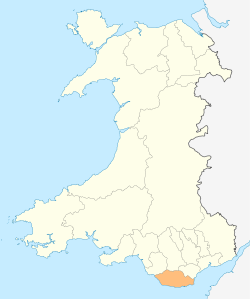Wenvoe Quarry
Wenvoe Quarry is a quarry between Wenvoe and Culverhouse Cross in the Vale of Glamorgan, south Wales. It is situated in an area off the A4050 road known as "The Alps", not far from Caerau and Culverhouse Cross on the outskirts of Cardiff. Operations at the quarry took off in the 1880s to supply the building of Barry Docks, and as of 1889 the quarry employed some 200 men.[1] The quarry is operated today by CEMEX UK Materials (Aggregates) Ltd. The closed Wenvoe Tunnel begins in close proximity to the quarry.

1889 accident
At around midday on 15 August 1889 three men, Charles Harding, George Richards and James Wills, were killed while boring a hole for blasting purposes, about 10 feet (3 m) from the face of the quarry. Large boulders fell on them and they fell to the bottom of the quarry, some 60 feet (18 m) below and were crushed, two of them beyond recognition. Harding was rescued alive, but died about an hour later from a fractured skull and complications shortly before arriving in hospital.[1]
Coed-y-Cymdda
Coed-y-Cymdda was an archaeological site that was excavated prior to its destruction by quarrying operations in 1978-1980. It was an earthwork hill-slope enclosure dating from the late bronze age. Archaeological finds indicated activity on the site until the Roman period.[2]
References
- Western Mail - Friday 16 August 1889, p.3, Accessed via The British Newspaper Archive (subscription required). Retrieved 19 November 2014.
- Wiles, John (16 March 2007). "Coed-y-cymdda Earthwork Enclosure". Coflein. Royal Commission on the Ancient and Historical Monuments of Wales. Retrieved 24 April 2017.
